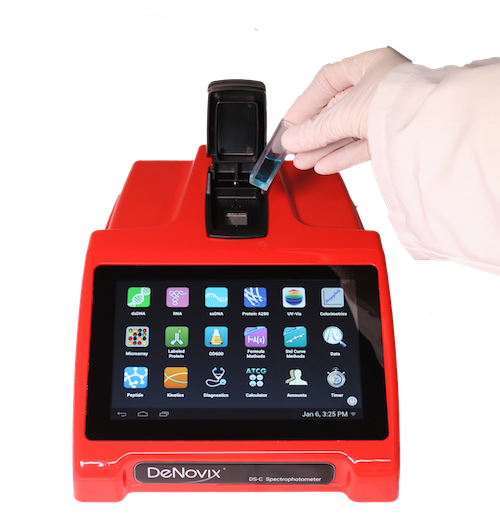All chemical compounds transmit, absorb and reflect light across a certain range of wavelengths. Spectrophotometry serves as a measurement of the levels that a chemical substance absorbs or allows the transmission of light.
Spectrophotometry finds use in a range of areas of science including life sciences, biochemistry, chemical engineering and clinical applications. Any application that deals with chemical substances or materials can employ this method.
Spectrophotometers are devices that measure the electromagnetic energy intensity at each wavelength of light in a particular region. A UV-Visible spectrophotometer operates in the near-infrared, ultraviolet and visible regions.1
Spectrophotometers are classified into two different types depending on their light source’s wavelength. UV-visible spectrophotometers use light over the ultraviolet and visible range of the electromagnetic spectrum. IR spectrophotometers use light above the infrared range of the electromagnetic radiation spectrum.2
How Does a Spectrophotometer Work?
Lamps provide a light source that strikes the diffraction grating. The grating acts as a prism, separating the light into the different wavelengths within. The grating must be rotated so that only a pre-determined light travels to the exit slit, interacting with the sample. The detector then captures the light of each wavelength of interest transmitted through the sample.3
The DS-11 Series Spectrophotometer from DeNovix
This spectrophotometer is a winning combination of microvolume UV-Vis absorbance, fluorescence and optional cuvette absorbance techniques, all available in one compact instrument. It offers the ability to quantify nucleic acids and protein samples quickly, with the broadest range of any microvolume spectrophotometer on the market.
This instrument offers excellent UV-Vis absorbance, even for samples that are generally challenging to measure, such as protein. It uses the unique DeNovix SmartPath™ technology, ensuring it is always calibrated and not subject to drift, which reduces downtime and increases long-term accuracy.
The DS-11 Series features built-in Wi-Fi, Ethernet and USB for flexible data exports and reporting.
The DS-C Cuvette Spectrophotometer
The DS-C Cuvette Spectrophotometer from DeNovix is simple to use and has excellent flexibility, sensitivity and dynamic range. It allows users to quantify biomolecules using industry-standard cuvettes with 8.5 mm z-height quickly and efficiently.
The DS-C features the most intuitive and powerful software in its class, with pre-installed EasyApps software for use with proteins, nucleic acids, colorimetric assays and more. This high-performance spectrophotometer allows users to save millions of samples automatically, create easy custom assays and use a broad range of disposable cuvettes and quartz. It also allows users to create simple kinetics methods by measuring two absorbance wavelengths across a measurement frequency and period that the user defines.
A longer measurement pathlength is beneficial to the high-particulate nature of bacterial cell cultures. The particulates in such samples scatter light, and a 10 mm pathlength offers a broader cross-section of the sample for the spectrophotometer’s light beam to move across. This allows for the highest level of accuracy and reproducibility when investigating these types of samples.
Find Out More
To find out more about spectrophotometers and how they work, take a look at our previous post here.
References and further reading:
- https://chem.libretexts.org/Bookshelves/Physical_and_Theoretical_Chemistry_Textbook_Maps/Supplemental_Modules_(Physical_and_Theoretical_Chemistry)/Kinetics/02%3A_Reaction_Rates/2.01%3A_Experimental_Determination_of_Kinetics/2.1.05%3A_Spectrophotometry
- https://chem.libretexts.org/Bookshelves/Physical_and_Theoretical_Chemistry_Textbook_Maps/Supplemental_Modules_(Physical_and_Theoretical_Chemistry)/Kinetics/02%3A_Reaction_Rates/2.01%3A_Experimental_Determination_of_Kinetics/2.1.05%3A_Spectrophotometry
- https://www.ncbionetwork.org/educational-resources/videos/how-does-spectrophotometer-work



